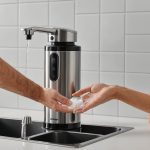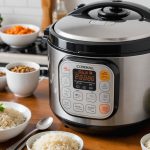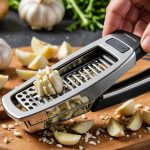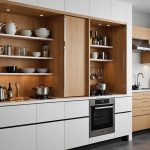Induction hobs are revolutionizing kitchens across the UK, offering both efficiency and precision in cooking. This guide explores the most energy-efficient models available, helping you save on utility bills while enjoying high-performance cooking. With options that cater to various budgets and needs, you’ll find solutions that not only benefit the environment but also elevate your culinary experience. Discover which induction hobs stand out in energy efficiency and performance, making informed choices easier than ever.
Overview of Energy-Efficient Induction Hobs
Exploring the world of energy-efficient induction hobs unveils a modern twist on traditional cooking methods. These hobs operate by using electromagnetic fields to directly heat cookware, ensuring minimal energy loss. This technology not only speeds up the cooking process but also offers precise temperature control, enhancing culinary experiences.
In parallel : Choosing the Perfect Ice Machine for Your Home Bar: A Comprehensive Guide
Benefits of Induction Cooking
Choosing induction cooking brings numerous advantages. Firstly, it is significantly more energy-efficient compared to gas or electric stoves. The direct transfer of energy to the pot or pan reduces heat wastage, making it a sustainable choice. Secondly, induction hobs are safer, as they remain cool to the touch, reducing the risk of burns. Lastly, their sleek design and easy-to-clean surfaces add aesthetic and practical value to any kitchen.
UK Market Trends
The UK market is witnessing a notable shift towards energy-efficient induction hobs. Consumers are increasingly drawn to the benefits of induction cooking, such as energy savings and enhanced safety features. Additionally, government incentives promoting energy efficiency are encouraging more households to adopt this technology.
This might interest you : Choosing the Perfect Ice Machine for Your Home Bar: A Comprehensive Guide
- Key Trends:
- Growing demand for sustainable appliances
- Increased awareness of energy efficiency
- Technological advancements in induction hob designs
The rise in popularity of induction hobs in the UK highlights a broader commitment to energy conservation and modern culinary innovation.
Top Energy-Efficient Induction Hobs in the UK
Exploring the best induction hobs in the UK reveals a range of innovative options designed for efficiency and style.
Review of the Top 5 Models
To help you make an informed decision, here are the top five energy-efficient induction hobs currently popular in the UK market:
- Bosch Serie 4 PUE611BB1E: Known for its sleek design and energy efficiency, this model features four cooking zones and touch controls.
- Neff T36FB41X0G: Offers precise temperature control and a power boost function for rapid heating.
- AEG IKE64450FB: Equipped with a bridge function to combine cooking zones, enhancing versatility.
- Samsung NZ64K5747BK: Features a virtual flame technology for visual cues, ensuring safer cooking experiences.
- Zanussi ZEI6840FBA: Provides efficient cooking with a simple interface, ideal for beginners.
Features and Specifications
These induction hobs boast advanced features like child locks, timers, and automatic pan detection. Specifications vary, with power outputs ranging from 2,000 to 3,700 watts.
Comparison of User Ratings
User feedback highlights the energy savings and ease of cleaning as major advantages. Ratings generally emphasize reliability and energy efficiency, with Bosch and Neff models often topping the list for user satisfaction.
Incorporating these energy-efficient induction hobs into your kitchen can elevate your cooking experience while promoting sustainability.
Understanding Energy Efficiency Ratings
Grasping the concept of energy efficiency ratings is crucial for selecting the right induction hob. These ratings, often displayed on EU energy labels, provide consumers with vital information about a product's energy consumption.
Explanation of Energy Efficiency Ratings
Energy efficiency ratings for induction hobs are determined by assessing the appliance's power usage and performance. Ratings typically range from A+++ (most efficient) to D (least efficient). These labels help buyers make informed decisions, ensuring they choose models that offer maximum cost savings.
Overview of EU Energy Labels
EU energy labels are standardized across Europe, making it easier to compare different appliances. They include details such as annual energy consumption and efficiency class. Understanding these labels can lead to significant cost savings over time, as more efficient models consume less electricity.
Potential Cost Savings
Investing in an induction hob with a high energy efficiency rating can result in substantial cost savings. For example, an A+++ rated hob uses less energy, reducing electricity bills. In the long run, this not only benefits your wallet but also contributes to environmental conservation.
- Benefits of High Ratings:
- Lower energy consumption
- Reduced utility bills
- Positive environmental impact
Buying Guide for Induction Hobs
Choosing the right induction hob requires careful consideration of features and installation needs.
Key Features to Consider
When purchasing an induction hob, focus on essential features such as power output, cooking zones, and control types. Models with multiple cooking zones offer versatility, allowing simultaneous cooking. Touch controls provide precision and ease of use. Consider hobs with safety features like child locks and automatic shut-off for added peace of mind.
Installation Tips and Requirements
Proper installation of an induction hob is crucial for optimal performance. Ensure your kitchen has the necessary electrical capacity, typically requiring a dedicated circuit. Ventilation should be adequate to prevent overheating. It’s advisable to hire a professional for installation to comply with safety standards and manufacturer guidelines.
Common Mistakes to Avoid
Avoid these common pitfalls when buying an induction hob:
- Overlooking the importance of cookware compatibility; ensure pots and pans are induction-ready.
- Ignoring the hob's size and kitchen space; measure your countertop to avoid fitting issues.
- Neglecting energy efficiency ratings; choose models with higher ratings for long-term savings.
Checklist for Buyers:
- Verify electrical requirements
- Confirm cookware compatibility
- Consider energy efficiency ratings
Selecting the right induction hob involves balancing features and installation considerations to enhance your cooking experience.
Cost Analysis of Induction Hobs
Evaluating the financial aspects of induction hob ownership.
Breakdown of Prices
When considering induction hob prices, it's essential to understand the range available. Basic models may start around £250, while high-end options can exceed £1,000. Factors influencing these costs include brand reputation, cooking zone features, and additional functionalities like touch controls and safety mechanisms.
Upfront Costs vs. Long-Term Savings
Although the upfront costs of induction hobs can be higher than traditional stoves, their long-term savings potential is significant. Induction technology is more energy-efficient, leading to reduced electricity bills. Over time, these savings can offset the initial investment, making induction hobs a cost-effective choice for many households.
Factors Influencing Cost
Several elements contribute to the cost of an induction hob:
- Brand and Model: Premium brands often carry higher price tags.
- Features: Advanced features like multiple cooking zones and smart technology can increase costs.
- Installation Requirements: Professional installation may add to the overall expense.
Understanding these factors can help consumers make informed decisions, balancing budget considerations with desired features. By evaluating both upfront costs and potential long-term savings, buyers can choose an induction hob that meets their financial and culinary needs.
Brand Comparisons in the Induction Hob Market
Exploring the landscape of induction hob brands reveals a competitive market where brand reputation plays a crucial role in consumer trust. Leading brands such as Bosch, Neff, and AEG dominate the market with their innovative designs and reliable performance.
Overview of Leading Brands
Each brand brings unique strengths to the table. Bosch is renowned for its energy efficiency and sleek designs, while Neff offers precision with advanced temperature controls. AEG stands out with versatile cooking options, catering to diverse culinary needs.
Analysis of Brand Reputation and Consumer Trust
Consumer trust is heavily influenced by a brand's history and product reliability. Bosch, with its long-standing reputation, often tops consumer preference lists. Neff's focus on safety and technology earns it commendations for innovation. AEG’s commitment to sustainability resonates with eco-conscious buyers.
Comparison of Warranty and Customer Service
When comparing warranty and customer service, differences become apparent. Bosch provides a comprehensive warranty with responsive customer support, enhancing consumer trust. Neff offers extended warranties, reflecting confidence in their product durability. AEG’s customer service is praised for its quick resolution of issues.
- Brand Comparison Highlights:
- Bosch: Energy efficiency, strong warranty
- Neff: Innovative features, extended warranty
- AEG: Sustainability focus, excellent customer service
Understanding these aspects helps consumers make informed decisions when selecting an induction hob brand.
User Testimonials and Experiences
Exploring user reviews reveals insightful experiences with various induction hobs, highlighting satisfaction rates and common themes. These testimonials provide a window into real-life usage, helping potential buyers make informed decisions.
Compilation of User Testimonials
Users frequently praise the energy efficiency and safety features of induction hobs. One customer noted, "The precise temperature control has transformed my cooking experience." Such feedback underscores the practical benefits these appliances offer in daily use.
Analysis of Common Themes
Common themes in customer experiences include ease of cleaning and the sleek design of induction hobs. Many users appreciate the rapid heating capabilities, which save time and energy. However, some mention the initial learning curve, emphasizing the need for compatible cookware.
- Common User Feedback:
- Enhanced cooking precision
- Reduced energy consumption
- Initial adaptation period
Satisfaction Rates and Implications
High satisfaction rates indicate that induction hobs meet consumer expectations for performance and efficiency. These rates suggest that buyers can expect a reliable and modern culinary tool. A significant number of users express contentment with their purchase, hinting at a positive return on investment.
Understanding these user reviews and experiences can guide potential buyers in selecting an induction hob that aligns with their needs and preferences.
Expert Insights on Energy Savings with Induction Hobs
Delving into expert advice on maximizing energy efficiency with induction cooking.
Expert Recommendations for Energy Savings
Experts suggest several strategies to optimize energy savings with induction hobs. Using cookware that matches the size of the cooking zone ensures efficient heat transfer. Additionally, preheating is unnecessary with induction technology, allowing for immediate cooking and further energy conservation.
Cooking Techniques for Enhanced Efficiency
Adopting specific cooking techniques can also boost induction cooking efficiency. For instance, using a lid while cooking traps heat, reducing energy consumption. Experts recommend maintaining a clean hob surface to ensure optimal performance. A well-maintained hob not only functions efficiently but also extends the appliance's lifespan.
Future Trends in Energy-Efficient Cooking Technology
The future of energy-efficient cooking technology is promising, with advancements focusing on smart features and connectivity. These innovations aim to enhance induction cooking efficiency by offering real-time energy usage feedback and automated cooking settings. Such developments are expected to further drive energy savings in modern kitchens.
- Key Tips for Energy Savings:
- Match cookware size to cooking zones
- Avoid preheating with induction hobs
- Use lids to conserve heat
Embracing these expert insights can lead to significant energy savings, making induction hobs a practical choice for environmentally conscious cooking.












